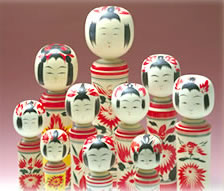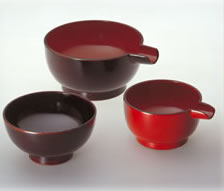Perhaps the most representative souvenirs of Naruko are the Naruko Kokeshi dolls. Their stout and balanced figures, with their innocent and cute expressions make them very popular. These traditional items—born out of the livelihood of the mountain village—will inspire memories of your trip. Why not take one home with you?
Naruko’s Traditional and Historic Craft Products Make Good Souvenirs.
Known throughout Japan, Naruko’s traditional kokeshi dolls are still made by hand by about 50 sincere and dedicated craftsmen soul. In Naruko, there are facilities where you can enjoy seeing demonstrations of kokeshi dolls being made and shops where you can experience kokeshi painting. Creative kokeshi dolls and wooden toys that utilize the techniques of kokeshi make excellent souvenirs! Naruko Shikki (lacquerware) with a history of over 300 years are another of Naruko’s traditional craft products. The attractiveness of Naruko Shikki lies in its glossy lacquering and rich feeling. Naruko has a variety of unique souvenirs. Why not take something home as a memento of your trip to Naruko?
Naruko Kokeshi

Local traditional craftworks that have been handed down from generation to generation by woodworkers.
It is said that Naruko Kokeshi began in the Bunka-Bunsei era of the Edo Period, about 200 years ago, when people who made a living as woodworkers in the deep mountains gave kokeshi dolls to their children. Kokeshi dolls, which have long been loved by children in the deep mountain as toys, later began to be sold as souvenirs and have developed into an adults’ collecting hobby and for ornamental purposes. Naruko Kokeshi dolls representing cute young girls from Michinoku (Tohoku) have the beauty of simplified shaping expressed through the minds of their creators who live surrounded by the nature in the mountain villages. Their unique shapes and patterns have been handed down to the present day. Five types of traditional kokeshi dolls are made in Miyagi Prefecture—Naruko Kokeshi, Sakunami Kokeshi, Togatta Kokeshi, Yajiro Kokeshi, and Hijiori Kokeshi—were each designated as a National Traditional Craft Product in 1981 under the name of “Miyagi Traditional Kokeshi.”
Unique skill of fitting the head in the body makes Naruko Kokeshi dolls squeak.
The most distinctive feature of Naruko Kokeshi dolls is the way that they squeak when you turn their head. The torso with bulging shoulders thins down a little towards the central part and gets thicker again towards the hem. This stable silhouette is another feature of Naruko Kokeshi dolls. With regard to the pattern, the gorgeous “Kasanegiku” pattern, created by drawing layers of a chrysanthemum viewed from the side is typical, and the “Hishigiku” pattern, featuring a large-flowered chrysanthemum from the front on the lower part of the body is also frequently used. Both patterns are quite graphic compared with other kinds of the traditional kokeshi dolls in Miyagi. On the oval-shaped head, the front hair is painted, and the innocent childlike facial expression adds a simple cuteness. The materials are mainly natural trees, including dogwood. Trees that are fully seasoned naturally are cut and shaped into a cylinder, and then the head and body are turned on a lathe. Next, the head is attached to the body using friction while the lathe is being turned. The feature of squeaking Naruko Kokeshi dolls attributes to this unique technique called “Kubi-ire” (fitting the head in the body). Finally, the kokeshi dolls are completed by careful painting.
New kokeshi boom among young women – soothing feeling from their simplicity and gentle smile.
Do you know that recently, more and more people are reaffirming the merits of kokeshi dolls, and that the “Third Kokeshi Boom” has arrived, following the prewar boom and the boom around 1975? Due to their attractive appearance, kokeshi dolls are becoming popular especially among young women. In kokeshi’s hometown of Naruko, not only traditional kokeshi dolls, but also unique ones, including the “Naruko Engi Matryoshka Kokeshi,” a matryoshka (Russian) doll of white birch painted by local kokeshi creators are becoming increasingly popular. There are many craft centers where visitors can enjoy seeing the production process of kokeshi dolls and experience kokeshi painting. In this way you can have a wide and deep experience of the attractiveness of kokeshi dolls. We would like to recommend Naruko Kokeshi dolls not only to kokeshi fans but also to visitors to Naruko as the best souvenir of Naruko!
Naruko Shikki
Naruko Shikki (lacquerware) is another of Naruko’s typical traditional craftwork. The attraction of the lacquerware is the simple warmth and excellent functionality created by craftsmen’s traditional techniques. Why not add Japanese color to your lifestyle with the simple but sophisticated Naruko Shikki?

Naruko Shikki has developed as an industry peculiar to Naruko, which is blessed with high-quality trees and lacquer.
It is said that the Naruko Shikki originated more than 350 years ago during the Kanei era (1624–43) in the Edo Period. Then, Date Danjo Toshichika, the third head of the Iwadeyama Date family, dispatched a lacquerer, Tamura Uhei, and a makie (gold or silver lacquering) craftsman, Kikuta Sanzo, to Kyoto to develop their skills in order to promote the Naruko Shikki. Because lacquerware as well as turned wooden articles are recorded as Naruko’s products in a book written in the late 18th century titled, Naruko-mura Fudoki Kakidashi (The Beginning of the Local History of Naruko Village), the lacquerware seems to have been already a major product in Naruko at that time. In addition, in the document written in the early 19th century titled, Urushidekidakaoboe (Record of Urushi Production), it is recorded that lacquer was collected in Naruko. Naruko Shikki has been handed down to the present day undergoing a number of technical innovations. In 1991, Naruko Shikki was designated as a National Traditional Craft Product. Even now, many lacquerware craftsmen have studios in Naruko where they continue to hone their skills.
Lacquer is applied repeatedly over and over to create the rich glossy surface of the lacquerware. These traditional techniques have been developed over long years.
The materials of Naruko Shikki are natural lacquer and natural tress including keyaki (Japanese zelkova) and horse chestnut. The production process is roughly divided into “Kiji-zukuri” (making the wooden item), “Shitaji-zukuri” (base coating), and “Urushinuri” (lacquering).” Kiji-zukuri has three types: “Hikimono (lathe work),” “Kakumono (joinery),” and “Magemono (bent work).” After finishing the process of the “Shitaji-zukuri” using the methods of “Urushi hon shitaji (base coating using urushi),” “Sabi shitaji (base coating using rust),” and Shibu shitaji (base coating using persimmon tannin),” through the processes of Nakanuri (middle coat) and Nakatogi (rubbing down), Uwanuri (top coat) is applied. In some cases, lacquerware is decorated by makie (gold or silver lacquering). There are different kinds of lacquering techniques, such as “Kijiro-nuri,” which exposes the grain of the wooden basis; “Benitamenuri,” which colors the wooden basis red with a pigment and finishes using semitransparent lacquer, “Togidashi,” “Murakumo,” and “Fukiurushi.” Among them, “Ryumon-nuri,” characterized by its marbled pattern, is a technique that was developed by Mr. Goichi Sawaguchi in 1951 and is known as a unique lacquering style peculiar to Naruko.
Naruko Shikki has reached the summit of the “beauty of utility” and increases its appeal the more you use it. Why not buy one as a souvenir?
The attractiveness of Naruko Shikki is definitely the simple texture utilizing the beautiful grain of the wood and the rich elegant lacquering. Although Naruko Shikki are of high value as craft products, many of the pieces are everyday items such as soup bowls, chopsticks, trays, and sweet bowls. Since the wooden basis of Naruko Shikki is thick and tough, and it is durable because it has been coated by lacquer many times, you can use it for a long time feeling fondness for it. Recently, the interior décor brand, “NARUKO,” which merges “shikki” (lacquerware) and “kokeshi dolls” (wooden toys), the two traditional craftworks that Naruko is most proud of, has been born, and modern products full of novel sensations have come on the scene one after another. Why don’t you pick your favorite?